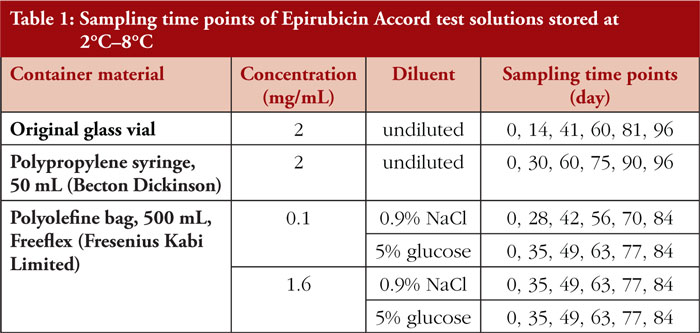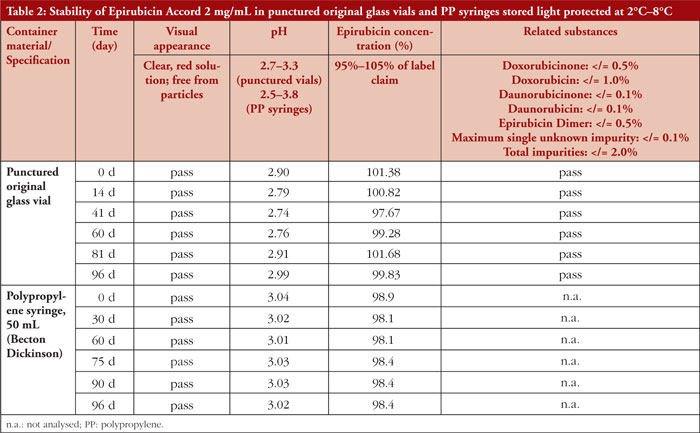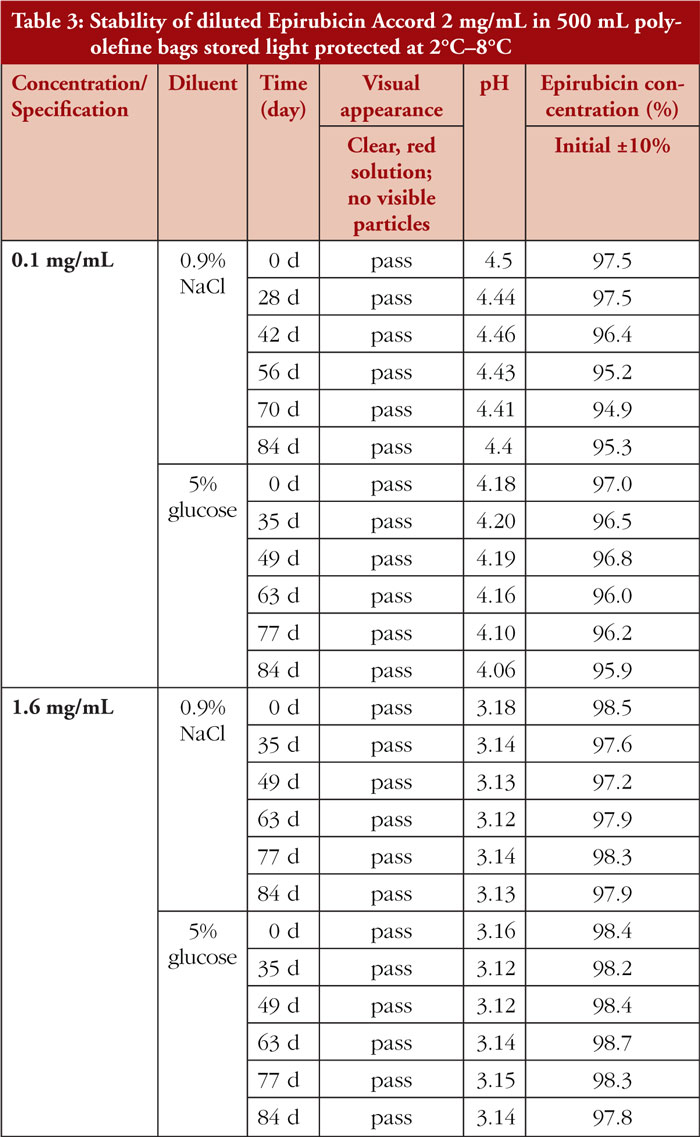Physicochemical stability of Epirubicin Accord 2 mg/mL in punctured original vials and polypropylene syringes and after dilution with 0.9% sodium chloride or 5% glucose solution in polyolefine bags
Published on 2024/09/11
Generics and Biosimilars Initiative Journal (GaBI Journal). 2024;13(2):65-7.
Author byline as per print journal: Irene Krämer, PhD; Frank Erdnuess, PhD; Judith Thiesen, PhD
|
Study objectives: To determine the physicochemical stability of Epirubicin Accord 2 mg/mL concentrate in original glass vials after first opening and after transfer to polypropylene (PP) syringes as well as diluted Epirubicin Accord solutions 0.1 mg/mL, 1.6 mg/mL in 0.9% sodium chloride solution or 5% glucose solution in polyolefine (PO) bags stored at 2°C–8°C for up to 96 days or 84 days. |
Submitted: 4 March 2024; Revised: 15 April 2024; Accepted: 26 April 2024; Published online first: 6 May 2024
Introduction
Epirubicin is an anthracycline antineoplastic agent intercalating into DNA and interferes with topoisomerase II, thereby inhibiting DNA synthesis. Its m ain indications are breast and gastric cancer, bladder carcinoma, and transarterial chemoembolization (TACE) in patients with hepatocellular carcinoma. Epirubicin is the 4’-epi-isomer of doxorubicin and is subject to the same hydrolysis reactions in acidic and alkaline media. Diluted epirubicin solutions (0.02 mg/mL–1 mg/mL) of different epirubicin brand products are reported to be physicochemically stable for up to 43 days according to published literature [1–5]. Epirubicin 2 mg/mL concentrate stored in polypropylene syringes is reported to be stable for 180 days at 4°C [6]. According to the Summary of Product Characteristics (SmPC), diluted Epirubicin Accord 2 mg/mL solutions are stable for 24 hours when stored at 2°C–8°C . Any unused portions of Epirubicin Accord concentrate must be discarded [7].
Study objectives
To determine the physicochemical stability of Epirubicin Accord 2 mg/mL concentrate in original glass vials after first opening, and in 50 mL polypropylene (PP) syringes, as well as after dilution with 0.9% sodium chloride solution or 5% glucose solution in 500 mL polyolefine (PO) bags to the epirubicin concentration s of 0.1 mg/mL and 1.6 mg/mL, stored protected from light at 2°C–8°C for up to 96 days.
Methods
Epirubicin test solutions were prepared under EU Class A conditions and in accordance with the principles of Good Manufacturing Practice . A total of six different test solutions were prepared by using the European Medicines Agency (EMA) licensed Epirubicin Accord 2 mg/mL (batch numbers N08252 and R10737). Test solutions were stored light-protected at 2°C–8°C . Samples were taken and analysed initially (Day 0) and at predetermined time points. For detailed information, see Table 1.
The physical stability of test solutions was assessed through visual inspections under standard laboratory light to detect any change s in colour, clarity, or the presence of particulate matter . Additionally, pH measurement s were conducted using a glass electrode calibrated with standard buffer solutions. Acceptance criteria for undiluted epirubicin solutions were set to pH 2.7–3.3 in original vials and 2.5–3.8 in PP syringes.
Chemical stability was determined via high-performance liquid chromatography (HPLC) analysis, which was validated for linearity of analytical response and acceptable precision [8]. The assay was proven to be stability-indicating for non-specific degradation of the parent drug. Acceptance criteria were set to epirubicin concentrations of ± 5% of the label claim for epirubicin concentrate in original vials and PP syringes, and an initial ±10% for diluted epirubicin test solutions [8]. In Epirubicin Accord 2 mg/mL test solutions in punctured glass vials, the type and quantity of related compounds were analysed by HPLC assay. Peaks of related substances were calculated as a percentage rate of the intact epirubicin peak . For acceptance criteria, see Table 2 [8].
Results
Epirubicin Accord 2 mg/mL concentrate in punctured vials and in PP syringes, stored light protected at 2°C–8 °C, remained physicochemically stable over the observation period of 96 days . For detailed results, see Table 2. Neither colour change, turbidity nor visible particles were noticeable during visual inspection. Results of pH measurements showed only slight variations during the observation period and stayed within the predetermined specification limits. The HPLC assays revealed only slight variations of epirubicin concentrations over time, considered to be related to assay variability (compare Table 2). In HPLC chromatograms of epirubicin concentrate in punctured vials, several peaks of related substances were detected . Two of them could be identified as doxorubicin (< 0.112%) and epirubicin dimer (< 0.291%), both not exceeding the acceptance criteria. Single peaks of unknown impurities amounted to less than 0.07%, and total impurities amounted to less than 0.6% of the main peak, thereby fulfilling the acceptance criteria.
Diluted Epirubicin Accord 2 mg/mL test solutions stored in PO bags at 2°C–8 °C with light protection remained physicochemically stable over the observation period of 84 days, irrespective of the concentration (0.1 mg/mL, 1.6 mg/mL) and vehicle solution (0.9% sodium chloride or 5% glucose solution) used. For detailed results, see Table 3.
Conclusion
Epirubicin Accord solution concentrate, 2 mg/mL in punctured original vials and in PP syringes, remained physicochemically stable under refrigeration over the observation period of 96 days. After dilution with 0.9% sodium chloride or 5% glucose infusion solution, epirubicin 0.1 mg/mL and 1.6 mg/mL test solutions remained physicochemically stable over the observation period of 84 days when stored light-protected at 2°C–8 °C.
Any unused portion of Epirubicin Accord 2 mg/mL concentrate can be used cost-effectively for 96 days when stored refrigerated in original glass vials or PP syringes. Epirubicin Accord, when diluted with 0.9% sodium chloride solution or 5% glucose solution in the concentration range of 0.1 mg/mL, to 1.6 mg/mL, can be prepared in advance and used over a period of 84 days when stored in PO bags and refrigerated at 2°C–8 °C.
Analysis was performed and documented by an accredited external laboratory. Results were carefully checked for plausibility and cautiously interpreted.
Funding sources
This study was funded by Accord Healthcare.
Competing interests: The authors Irene Krämer, Frank Erdnuess, and Judith Thiesen have no competing interest s to declare.
Provenance and peer review: Not commissioned; externally peer reviewed.
Authors
Professor Irene Krämer, PhD
Frank Erdnuess, PhD
Judith Thiesen, PhD
Department of Pharmacy, University Medical Center of the Johannes Gutenberg University Mainz, 1 Langenbeckstraße, DE-55131 Mainz, Germany
References
1. Wood MJ, Irwin WJ, Scott DK. Stability of doxorubicin, daunorubicin and epirubicin in plastic syringes and minibags. J Clin Pharm Ther. 1990;15(4):279-89.
2. Sautou-Miranda V, Brigas F, Thibault M, Chopineau J. Compatibility of doxorubicin, daunorubicin and epirubicin with low-density polyethylene and polyvinyl chloride, and stability in various conditions of storage. Eur J Hosp Pharm. 2001;7(3):108-15.
3. De Vroe C, De Muynck C, Remon JP, Samson M. A study on the stability of three antineoplastic drugs and on their sorption by i.v. delivery systems and end-line filters. Int J Pharm. 1990;65(1-2):49-56.
4. Adams PS, Haines-Nutt RF, Bradford E, Palmer A, Rowland CG. Pharmaceutical aspects of home infusion therapy for cancer patients. Pharm J. 1987;238:476-8.
5. Sewell GJ, Rigby-Jones AE, Priston MJ. Stability of intravesical epirubicin infusion: a sequential temperature study. J Clin Pharm Ther. 2003;28(5):349-53.
6. Pujol M, Munoz M, Prat J, Girona V, de Bolós J. Stability study of epirubicin in NaCl 0,9% injection. Ann Pharmacother. 1997;31(9):992-5.
7. Accord Healthcare Limited. Summary of product characteristics for Epirubicin Accord 2 mg/mL concentrate for solution for infusion. Available from: https://cdn.accord-healthcare.com/ie/public/spc/spc_doxorubicin_2_mg.ml_concentrate_for_solution_for_infusion.pdf
8. Accord Healthcare Limited. Data for HPLC assay and acceptance criteria on file; 27-02-14.
|
Author for correspondence: Judith Thiesen, PhD, Department of Pharmacy, University Medical Center of the Johannes Gutenberg University Mainz, 1 Langenbeckstraße, DE-55131 Mainz, Germany |
Disclosure of Conflict of Interest Statement is available upon request.
Copyright © 2024 Pro Pharma Communications International
Permission granted to reproduce for personal and non-commercial use only. All other reproduction, copy or reprinting of all or part of any ‘Content’ found on this website is strictly prohibited without the prior consent of the publisher. Contact the publisher to obtain permission before redistributing.





